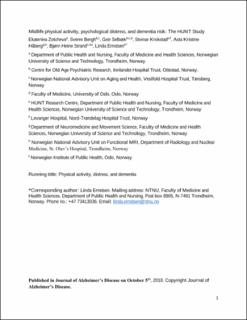| dc.contributor.author | Zotcheva, Ekaterina | |
| dc.contributor.author | Bergh, Sverre | |
| dc.contributor.author | Selbæk, Geir | |
| dc.contributor.author | Krokstad, Steinar | |
| dc.contributor.author | Håberg, Asta | |
| dc.contributor.author | Strand, Bjørn Heine | |
| dc.contributor.author | Ernstsen, Linda | |
| dc.date.accessioned | 2022-11-25T14:26:35Z | |
| dc.date.available | 2022-11-25T14:26:35Z | |
| dc.date.created | 2018-10-17T13:23:11Z | |
| dc.date.issued | 2018 | |
| dc.identifier.citation | Zotcheva, E., Bergh, S., Selbaek, G., Krokstad, S., Haberg, A. K., Strand, B. H., & Ernstsen, L. (2018). Midlife Physical Activity, Psychological Distress, and Dementia Risk: The HUNT Study. J Alzheimers Dis, 66(2), 825-833. doi: 10.3233/jad-180768 | en_US |
| dc.identifier.issn | 1387-2877 | |
| dc.identifier.uri | https://hdl.handle.net/11250/3034159 | |
| dc.description.abstract | BACKGROUND:
Physical activity (PA) is associated with a decreased dementia risk, whereas psychological distress (distress) is linked to an increased dementia risk.
OBJECTIVE:
We investigated independent and joint associations of midlife moderate-to-vigorous PA (MVPA) and distress with incident dementia.
METHODS:
Our study comprised 28,916 participants aged 30-60 years from the Nord-Trøndelag Health Study (HUNT1, 1984-1986). Data on MVPA and distress from HUNT1 was linked to the Health and Memory Study in Nord-Trøndelag for dementia case identification. Participants were followed from 1995 until 2011. We used adjusted Cox regression models to estimate hazard ratios (HRs) and 95% confidence intervals (95% CI).
RESULTS:
In fully adjusted analyses, MVPA was associated with a reduced dementia risk (HR 0.81, 95% CI 0.62-1.06), compared to no MVPA. Distress was associated with an increased dementia risk (HR 1.30, 95% CI 0.99-1.70). Compared to distressed participants not taking part in MVPA, non-distressed no-MVPA participants had a reduced dementia risk (HR 0.72, 95% CI 0.54-0.96). The same applied to distressed MVPA participants (HR 0.50, 95% CI 0.22-1.14), and non-distressed MVPA participants (HR 0.63, 95% CI 0.44-0.90). Our results indicated an additive interaction between MVPA and distress on dementia risk.
CONCLUSION:
Our results suggest that midlife MVPA reduces risk of incident dementia among both distressed and non-distressed individuals. | nb_NO |
| dc.language.iso | eng | en_US |
| dc.subject | Anxiety | nb_NO |
| dc.subject | cognition | nb_NO |
| dc.subject | dementia | nb_NO |
| dc.subject | depression | nb_NO |
| dc.subject | exercise | nb_NO |
| dc.subject | psychological stress | nb_NO |
| dc.subject | Alzheimers disease | nb_NO |
| dc.title | Midlife Physical Activity, Psychological Distress, and Dementia Risk: The HUNT Study | en_US |
| dc.title.alternative | Midlife Physical Activity, Psychological Distress, and Dementia Risk: The HUNT Study | en_US |
| dc.type | Peer reviewed | en_US |
| dc.type | Journal article | en_US |
| dc.description.version | acceptedVersion | nb_NO |
| dc.source.pagenumber | 9 | en_US |
| dc.source.volume | 66 | en_US |
| dc.source.journal | Journal of Alzheimer's Disease | en_US |
| dc.source.issue | 2 | en_US |
| dc.identifier.doi | 10.3233/JAD-180768 | |
| dc.identifier.cristin | 1621069 | |
| cristin.unitcode | 1991,0,0,0 | |
| cristin.unitname | Sykehuset Innlandet HF | |
| cristin.ispublished | true | |
| cristin.fulltext | postprint | |
| cristin.qualitycode | 1 | |
